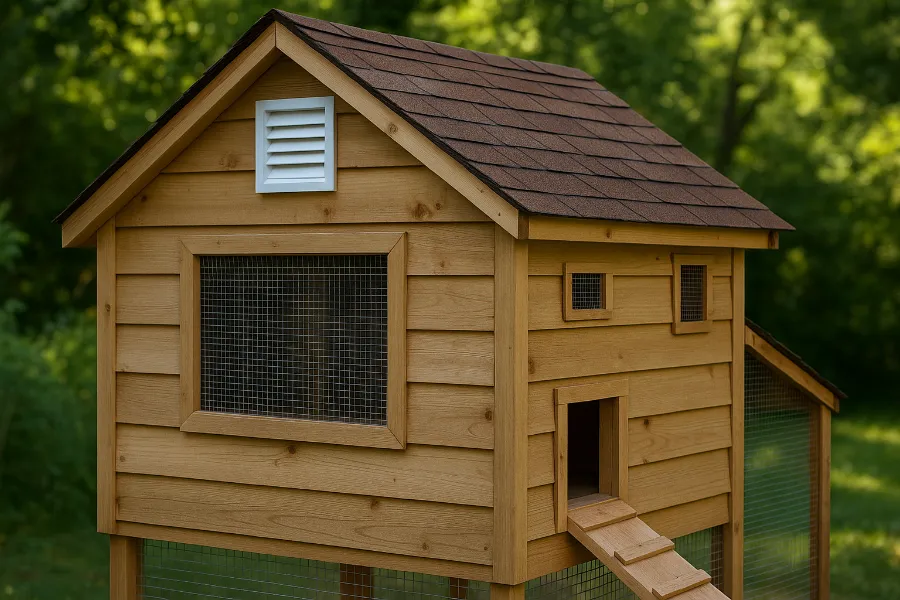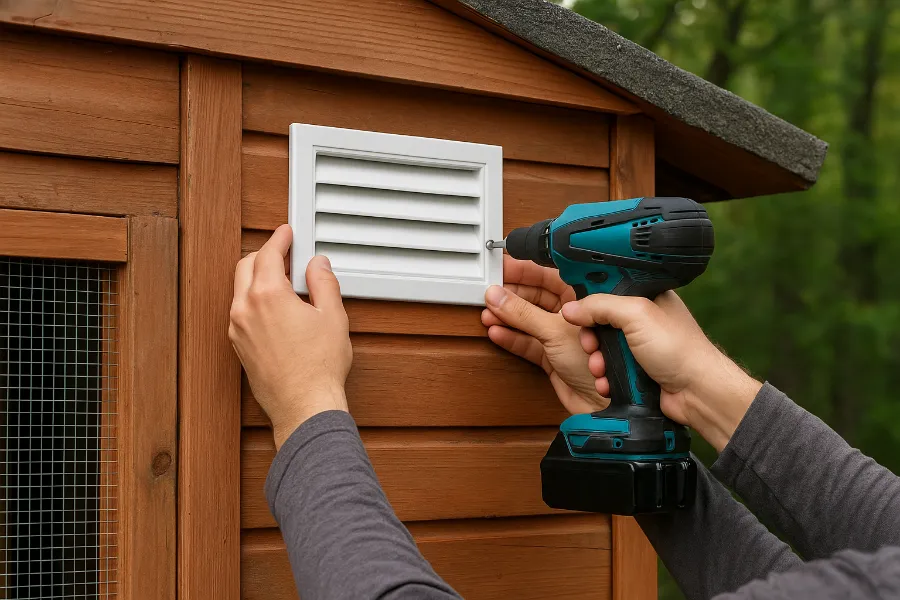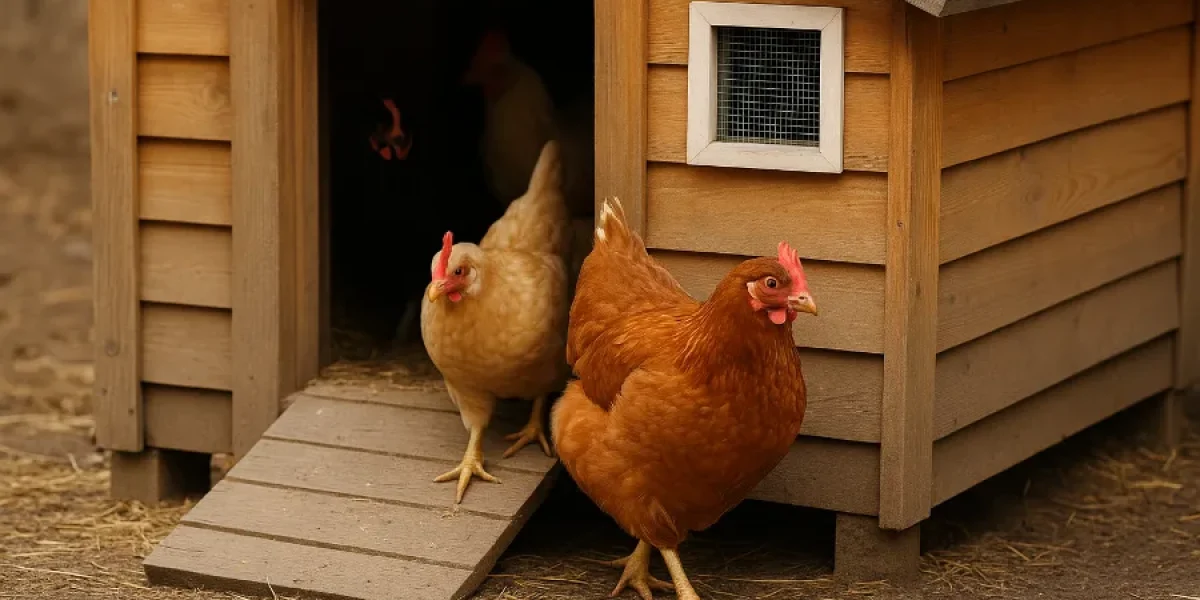When I built my first coop, I thought insulation and predator-proofing were everything—until I opened the door one summer morning and got hit with a thick wall of ammonia smell. That’s when I learned the hard way that chicken coop ventilation is one of the most overlooked yet vital parts of raising healthy chickens.
Whether your setup is a repurposed shed or a sleek new hen house, airflow makes or breaks your flock’s comfort. Over the years, I’ve tried just about every setup imaginable—from cheap DIY vents to fancy solar-powered fans—and I’ve learned what really works for simple chicken coop ventilation ideas for small coops.
This guide shares my favorite options—from budget-friendly fixes to high-end upgrades—plus real-life dos and don’ts that can keep your coop fresh, dry, and healthy all year long.

How Much Ventilation Does a Chicken Coop Need?
When people ask me, “How much ventilation does a chicken coop need?” my answer is simple: more than you think.
A good rule of thumb is one square foot of ventilation per bird—and even more if you live somewhere humid or hot. That might sound like a lot, but once you add windows, gable vents, or a ridge vent, it adds up quickly.
Think of ventilation as your coop’s lungs. Stale, damp air has to go somewhere, and if it doesn’t, you’ll start noticing:
- Condensation on the roof and walls
- Damp bedding that clumps and smells
- The unmistakable ammonia smell in the chicken coop
- Chickens sneezing or acting sluggish
In summer, open everything safely possible to prevent overheating. In winter, keep vents high above roosting level so moisture escapes without chilling your flock. It’s all about steady airflow—not gusty drafts.
Solar Fan for Chicken Coop: A Low-Energy Lifesaver
One of my favorite modern upgrades is a solar fan for chicken coop setups. These little devices run on sunlight alone, so you don’t need to run any wires or electricity to your coop.
They pull hot, moist air up and out—especially helpful on muggy days when even the shade feels like a sauna. Mount them near the top of your coop (gable or roof level) so they can vent rising heat efficiently.
I love that they only run when the sun’s out—the very time your coop is at its hottest. It’s a “set it and forget it” solution that costs around $60–$100 but lasts for years.
If your coop tends to get stuffy despite open vents, a solar fan might be the simplest upgrade that changes everything.

Solar Powered Fan for Chicken Coop: When You Need More Airflow
A step up from the basic version is the solar powered fan for chicken coop that includes a small rechargeable battery. These fans store solar energy during the day and can keep air moving into the evening.
I use one in my larger coop with eight hens. On humid nights, that gentle hum keeps the air from feeling stale without chilling the birds. It’s a smart investment for anyone who deals with humidity or has a tightly sealed modern coop.
Pair your solar fan with passive vents down low. As hot air exits the top, fresh air naturally draws in from below—creating a perfect cycle.
Gable Vent Chicken Coop: Classic, Reliable Airflow
No matter how fancy technology gets, the gable vent chicken coop design remains one of the simplest and most reliable ventilation systems around.
Gable vents sit near the roof peak on both ends of the coop. Warm, moist air rises naturally and escapes, while cooler air enters from lower openings. You don’t need power, and you don’t risk drafts around your birds.
If your coop doesn’t have them yet, it’s an easy DIY upgrade—just cut triangular openings under each gable and cover them with hardware cloth for chicken coops (never plain chicken wire).
Hardware cloth matters because it’s stronger, keeps raccoons out, and allows full airflow. You can paint the vent frames to match your coop or leave them rustic for that farmhouse charm.
Chicken Coop Ventilation Fan: Modern Help for Hot Weather
In the peak of summer, even natural ventilation can fall short. That’s when I bring in a chicken coop ventilation fan—a small, weather-rated fan designed to keep air circulating.
These are perfect if your coop sits in a corner of the yard where breezes rarely reach. I like mounting mine near the roof, angled slightly upward, so it pulls the warmest air out.
Fans are especially useful if you:
- Have more than six birds in a small coop
- Live in a humid or coastal region
- Store feed inside the coop, which adds moisture
If you’re worried about electricity, go solar or use a battery-powered fan with a timer. Even running it a few hours a day can make a huge difference in smell and comfort.

Ammonia Smell in Chicken Coop: What It Tells You
That ammonia smell in chicken coop air is more than unpleasant—it’s dangerous. It means waste moisture is trapped inside, and ammonia from droppings is building up faster than air can escape.
If you catch that sharp scent when you open the coop door, it’s your signal to improve airflow or clean more often. Even low levels of ammonia irritate your chickens’ eyes and lungs, which can lead to respiratory disease or frostbite in winter.
Here’s what helps immediately:
- Add more ventilation up high
- Stir or replace bedding
- Make sure waterers aren’t leaking
- Use coop refreshers or drying agents on the floor
Good ventilation is preventive medicine—it fixes ammonia before it becomes a problem.
Chicken Coop Building Ideas for Better Airflow
If you’re planning a new build or upgrading an old structure, design for ventilation first—not last.
Here are some chicken coop building ideas that make airflow effortless:
- Raised Coops: Elevate the floor 1–2 feet off the ground. The airflow underneath helps dry the floor and prevents dampness.
- Cross Ventilation: Place vents or windows on opposite sides of the coop to let air move straight through.
- Roofline Gaps: Leave a small, mesh-covered gap under the roof eaves for continuous airflow.
- Louvered Vents: Adjustable slats allow you to fine-tune airflow for summer or winter.
- Removable Panels: Create seasonal covers you can slide on or off as needed.
You don’t need to reinvent the wheel—just make sure your coop can breathe.
Roof Vent Chicken Coop: The Overhead Advantage
A roof vent chicken coop setup works wonders for coops with pitched or barn-style roofs. These vents are built right into the roofline, allowing hot air to rise naturally and escape.
You can buy circular turbine vents or long ridge vents that span the entire peak. Either way, make sure they’re fitted with weather hoods or mesh to keep out rain and pests.
In one of my older coops, I installed two small metal roof vents from a home improvement store for under $30 each. The difference was night and day—the coop stayed drier, and the wood no longer showed mildew spots.
Paired with soffit vents under the eaves, roof vents create perfect top-down airflow.
Hardware Cloth for Chicken Coops: The Unsung Hero of Ventilation
Every vent, window, or opening should be covered with hardware cloth for chicken coops—not chicken wire.
Here’s why:
- Chicken wire keeps chickens in.
- Hardware cloth keeps predators out.
The openings are small enough to block rats, snakes, and raccoons but still allow airflow. I attach it with screws and washers instead of staples—it’s stronger and lasts through bad weather.
I’ve even used hardware cloth on the underside of raised coops to add airflow while keeping predators from digging in. It’s not glamorous, but it’s essential for safe, breathable design.
Modern Chicken Coop Designs That Get Ventilation Right
If you’re starting from scratch, look at modern chicken coop designs—they’ve learned from decades of trial and error.
These designs often feature:
- Built-in ridge and soffit vents for automatic circulation
- Insulated walls that stay dry and reduce condensation
- Integrated solar systems for light and airflow
- Sliding vent panels that adjust with the seasons
Newer coops on the market balance airflow and warmth far better than older models. They’re proof that you can have good ventilation and protection from the elements—it doesn’t have to be one or the other.
Balancing Airflow Across the Seasons
One of the trickiest parts of managing ventilation is adjusting it through the year.
In summer, you want as much open space as possible—vents, windows, even propped-up doors if it’s predator-safe. In winter, the instinct is to seal everything tight, but that’s the worst thing you can do.
Warm air from your chickens still carries moisture, which condenses on cold surfaces and leads to frostbite. Instead, keep upper vents open and block only direct drafts.
I use removable wooden flaps over my lower vents during cold snaps—it keeps the roost area calm while still letting moisture escape through higher vents.
Chicken Coop Ventilation Ideas by Budget
| Budget Range | Options | Notes |
|---|---|---|
| In-Budget ($0–$25) | Roofline gaps, reused windows, gable vents with mesh | Great for small backyard coops |
| Mid-Range ($25–$75) | Louvered vents, ridge vents, soffit vents | Balanced cost and performance |
| Premium ($75–$150+) | Solar or electric fans, cupolas, automatic vent systems | Perfect for large or modern coops |
You don’t need a big wallet to get good airflow—just good planning.
Chicken Coop Ventilation Dos and Don’ts
Over the years, I’ve made plenty of mistakes, so learn from mine.
DO:
- Keep vents above roost height.
- Use hardware cloth, not chicken wire.
- Allow at least one square foot of ventilation per bird.
- Check vents regularly for debris or cobwebs.
- Keep airflow consistent year-round.
DON’T:
- Close every vent in winter.
- Aim fans directly at your chickens.
- Ignore condensation or smell—it’s your first warning.
- Skip predator-proofing vents.
- Forget about cleaning—airflow only helps if bedding is dry.
Good ventilation isn’t about perfection; it’s about consistency.

My Favorite Simple Chicken Coop Ventilation Ideas for Small Coops
If you’re feeling overwhelmed, start small. Here are three of my go-to solutions that any backyard keeper can handle:
- Add a Gable Vent: Quick, effective, and low-cost. Keeps air moving all year.
- Install a Solar Fan: Automatic airflow on hot days—no electricity required.
- Cut Roofline Gaps: Hidden, continuous airflow that works even in rain.
Each of these can transform the air quality in your coop within a day—and your hens will thank you with brighter combs and steadier egg production.
Final Thoughts: Breathe Easy, Flock Happy
After a few seasons of trial, error, and sweaty afternoons cleaning out musty coops, I finally realized this: chicken coop ventilation isn’t just a design feature—it’s the secret to a thriving flock.
No matter how big or small your setup, your coop needs to breathe just like your chickens do. From gable vents to solar fans, every bit of airflow you add pays off in health, cleanliness, and peace of mind.
Keep it simple, stay consistent, and let your coop tell you what it needs. When the air smells fresh and the bedding stays dry, you’ll know you’ve got it right.
FAQs
Good ventilation removes moisture, heat, and ammonia fumes, keeping your chickens healthy and comfortable. Without airflow, coops can become damp, smelly, and harmful to your flock’s lungs.
Aim for at least one square foot of ventilation per bird. Adjust seasonally—keep upper vents open year-round to let moisture escape without causing drafts.
Use gable vents, roof vents, or a small solar fan to circulate air. Combining high and low openings allows heat to rise and fresh air to flow naturally.
No. Even in cold weather, your coop needs ventilation to prevent condensation and frostbite. Just ensure vents are placed above roosting level to block direct wind.
Ammonia buildup comes from damp bedding and poor airflow. Improve ventilation, clean regularly, and use absorbent bedding to reduce odor.
Yes, a solar fan is an easy, energy-free way to remove heat and humidity. It runs during the hottest hours, keeping air fresh without electricity.
Always use hardware cloth instead of chicken wire. It keeps predators out while allowing full airflow through vents and windows.













